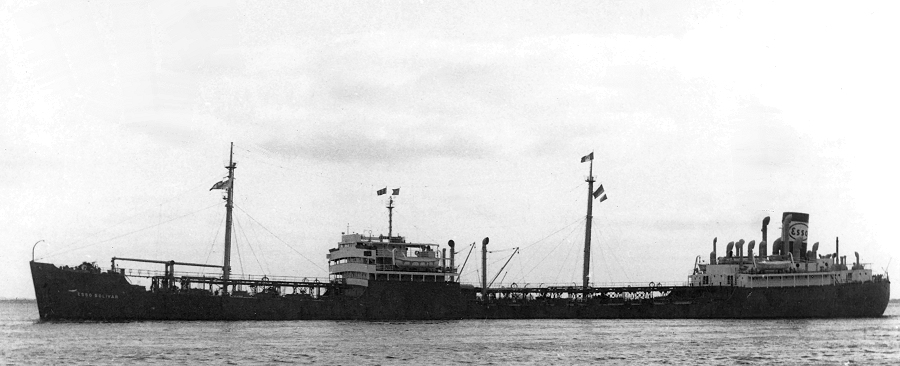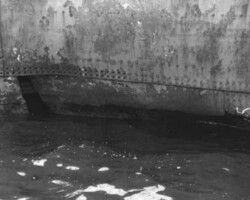



| Ship | Built | Hull | GRT | DWT | Length | Beam | Comments |
|---|---|---|---|---|---|---|---|
| Esso Bolivar | 1937 | 568 | 10,728 | 15,266 | 506’8″ | 69’9″ | Propelled by two 8-cylinder diesel engines driving a single screw. Damaged by U-126 torpedo March 8, 1942. Repaired and placed back in service. Appears to have been scrapped c.1962. |
Esso Bolivar was built in 1937 by Fried Krupp Germaniawerft A. G., Kiel Germany. She was a combination of company design and foreign construction. Her cargo capacity was 128,894 barrels and she was designed with a cargo pumping rate of 4,500 barrels per hour. Her diesels developed 4,100 BHP, giving her a rated speed of 11.6 knots. The vessel also had accommodations for twelve passengers.
One incident in Esso Bolivar‘s career bears mentioning. She left Bayonne on Saturday, 21 February 1942 bound for Aruba. They made a small detour into the Chesapeake Bay on 27 February for a test and inspection of their degaussing system, and to receive routing instructions from the Navy before proceeding. On the afternoon of 1 March, they left for Aruba. Since there were no convoys in those early days of the war, Esso Bolivar travelled alone. At about 2:20a.m. on Sunday, 8 March, a German submarine fired two torpedoes and began shelling the ship . One torpedo missed the bow of the ship and continued harmlessly on. The other torpedo struck her starboard side aft of the midship deckhouse. Luckily, the ship was not carrying a petroleum cargo, but was carrying a load of freshwater, commissary stores and deck cargo, or this would likely have been the explosive end of her. She was approximately 30 miles southeast of Guantanamo Bay, Cuba, and the Master, Captain James M. Stewart, turned toward the Naval Station there in an attempt to get closer to support, while trying to outrun the submarine. He directed the radio operator to send an SOS, and an acknowledgement was received just before the radio was put out of action by a shellburst.
At about 3:10a.m. the ship was ordered abandoned. The crew took to the lifeboats and rafts, or what was left of them. Most had been damaged by shellfire from the submarine, and the submarine continued to fire machine guns at the few lifeboats and rafts as the tried to pull away. Some resourceful crew members, led by the Chief Engineer, used vegetables and other floating debris from the burning ship to plug holes in their boats.
For over two hours the submarine continued to harrass the ship, firing shells and machine gun fire at it. Finally, it circled the ship twice, playing it’s searchlight across it as it did. About that time, a naval vessel from Guantanamo Bay fired a starshell, illuminating the whole scene brilliantly, and the submarine submerged and vanished. Luckily for the crew, the Navy had heard the SOS and also the shellfire, and had sent ships to investigate.
The crew was picked up by the minesweeper, USS Endurance, and the destroyer, USS Stringham, sometime in the morning. They were taken to Guantanamo Bay and treated for their wounds in the infirmary, and allowed to sleep. During the day, the crew discussed the situation and they agreed with the Chief Engineer, the senior surviving officer, that the ship could be saved. They were loaded onto the net tender Mulberry and returned to the ship around 9:00a.m on Monday, 9 March. By about 11:00a.m. they were underway on their own power, and pulled into Guantanamo Bay for temporary repairs. There they remained until 25 March, having I-beams welded across the hole left by the torpedo, but no shell plating. The ship left for Mobile on the 25th under it’s own power with a naval yacht for escort. They arrived around 10:00p.m. on 31 March for permanent repairs.
Esso Bolivar continued to serve proudly during the rest of the war. She made a total of 94 voyages, carrying a total of 9,303,682 barrels of cargo between 1939 and 1945.

